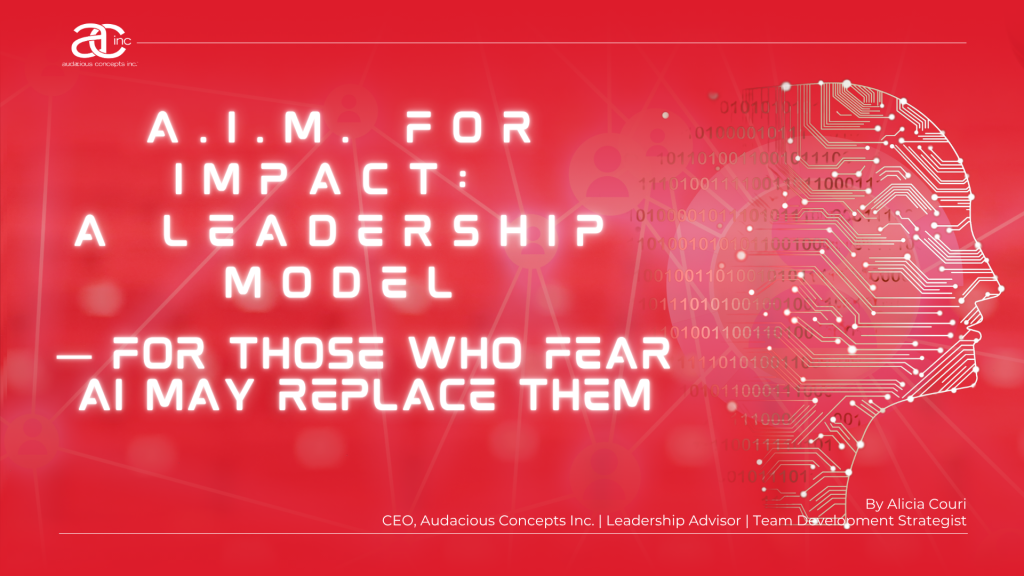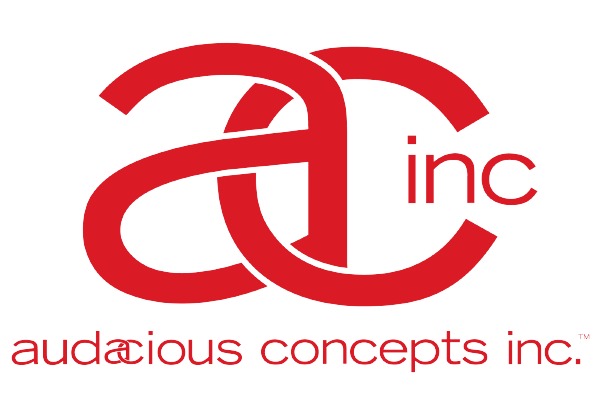
By Alicia Couri
CEO, Audacious Concepts Inc. | Leadership Advisor | Team Development Strategist
You’ve seen it.
AI is moving fast. It’s changing how we communicate, plan, hire, and make decisions.
And even if you’re not openly resisting it, you might be quietly thinking:
“Where do I fit now?”
“What happens to my value when machines can do what I used to be known for?”
If those questions feel familiar, you’re not alone.
Let’s say you’re in a leadership role—experienced, strategic, respected.
You’ve built a reputation on intuition, performance, and results.
But now, your team is experimenting with AI tools that generate faster reports, cleaner proposals, and sharper analytics than you ever imagined.
And suddenly, you feel… paused.
Not obsolete. But not central either.
That tension?
That’s exactly where many leaders are right now.
🤖 The Leadership Identity Shift No One Prepared You For
Imagine this:
You used to be the person everyone came to for clarity, guidance, and big-picture insight.
But now, team members ask AI for insights—and sometimes, it answers faster and with fewer errors.
And you begin to wonder if your experience, your instincts, your judgment still hold the same weight.
This is the internal disruption AI brings.
Not just to how we work—but to how we see ourselves as leaders.
But here’s the truth:
AI doesn’t erase your value.
It reshapes where your value lives.
You are no longer valuable because you hold all the answers.
You are valuable because you know how to ask better questions, make wiser decisions, and lead people through the unknown.
And that’s where the A.I.M. Model™ comes in.
🔹 A — Amplify What AI Can’t Replace
When people talk about the future of work, they often ask:
“What can humans still do better than machines?”
The answer isn’t always flashy—but it’s powerful.
It’s what happens in a moment of silence during a tough conversation.
It’s what’s communicated through body language in a room full of tension.
It’s the decision to wait, to ask again, to dig deeper—when AI would’ve already moved on.
These are the human traits that can’t be coded, simulated, or scaled. And they matter more now than ever.
🧠 Conative Strengths: The Human Operating System
Unlike personality or skills, your conative strengths—how you instinctively take action—are hardwired.
Tools like the Kolbe Index™ reveal whether you initiate with fact-finding, follow-through, quick-start action, or hands-on implementation.
AI can gather data. But it doesn’t have instinct.
It doesn’t know when to push or when to pause.
It can’t predict how your team will feel the weight of a decision—even when the numbers look perfect.
Leaders who understand their conative strengths can:
- Delegate more effectively
- Solve problems faster and with less friction
- Reduce burnout by aligning roles to natural effort, not just skills
This is your invisible edge—and AI can’t touch it.
💬 Emotional Intelligence + Non-Verbal Cues
AI can mimic tone.
It can even simulate empathy with the right language model.
But what it can’t do is read the room.
It can’t:
- Feel the energy shift when someone shuts down
- Notice tension build during a Zoom call
- Detect discomfort behind a polite “yes”
That’s your domain.
Great leaders pick up on these signals, pause before reacting, and communicate in ways that restore psychological safety—something no algorithm has mastered.
🤝 Collaboration & Decision-Making in Complexity
AI can offer options. But it doesn’t take responsibility.
It doesn’t weigh interpersonal dynamics, timing, or culture.
You do.
Leadership is often about making the right call in an imperfect moment.
And doing it in a way that brings people along—not leaves them behind.
The more complex the environment, the more your value rises—not as the smartest person in the room, but as the one who knows how to align talent, read nuance, and lead with intention.
Bottom line?
AI gives speed.
You give wisdom.
The smartest thing a leader can do right now isn’t to compete with AI—it’s to amplify what makes them irreplaceable.
And that starts by knowing where your real power lies.
🔹 I — Integrate the Right Tools Intentionally
Let’s be honest: the sheer number of AI tools flooding the market is enough to make any leader pause.
Every day, there’s a new platform that promises to streamline your inbox, optimize your calendar, write your reports, analyze your pipeline, or find your next hire.
It’s tempting to chase the newest solution—but doing so without strategy can lead to tool fatigue and team burnout.
The goal isn’t to use more tools.
It’s to use the right tools—on purpose, with intention.
When you integrate AI into your leadership toolkit, it should do one thing above all else:
→ Free you to lead more powerfully, not more frantically.
🧭 AI for Decision Support, Not Replacement
AI thrives in logic and pattern recognition. It’s brilliant at surfacing options, forecasting trends, and flagging risks.
But what it doesn’t do is take responsibility.
It doesn’t weigh culture, context, or character.
You still own the judgment.
Use AI to make better decisions faster—but not to offload the leadership of those decisions.
🧩 Smarter Hiring Starts with Human + Data Alignment
Hiring isn’t just about filling roles—it’s about building synergy. And that starts with understanding the human dynamics AI can’t calculate.
That’s why I integrate tools like:
- Predictive Index (PI): to uncover behavioral drives, cognitive fit, and manager/team alignment
- Kolbe™ + the RightFit® RoleMap: to map natural conative strengths to job functions
This combination creates clarity around:
- Who’s best suited for the role (not just who can do it)
- Where misalignment is causing friction or burnout
- How to restructure teams around instinctive flow—not forced performance
You’re not just hiring people who “fit the job.”
You’re hiring people who energize the team, accelerate outcomes, and communicate with less friction.
That’s AI + human insight, working hand-in-hand.
⚙️ Use Tech to Amplify Productivity—Not Add Chaos
Yes, AI can help you do more.
But doing more of the wrong things, faster, isn’t progress.
The leaders who thrive aren’t the ones using the most tools.
They’re the ones who:
- Choose AI tools that match their strategic goals
- Train their teams to use them with confidence
- Set boundaries to avoid the trap of constant tech-switching
📌 Tip: Don’t adopt every new app. Pick 1–2 tools that align with your business goals and your leadership style—and master them before adding more.
Integration isn’t about replacement—it’s about recalibration.
When you align your tech with your team’s natural strengths, you don’t just save time—you unlock potential.
And that’s what leadership in the age of AI is really about.
🔹 M — Mobilize Your Team with Purpose
Let’s say you’ve embraced AI. You’ve identified your human edge. You’ve integrated tools that make your work smarter and more strategic.
Now comes the hardest part:
Getting your team to believe in the vision—and move with you.
Because while tech adoption is one hurdle, mindset alignment is where transformation actually sticks.
Here’s what most leaders underestimate:
- The uncertainty AI creates in your team
- The unspoken fear of being replaced
- The quiet resistance that sounds like compliance but feels like disengagement
You can’t ignore it.
You must mobilize through it.
💬 Start with Trust, Not Tech
The best AI tools in the world won’t create results if your people don’t understand why they’re being used—and where they still matter.
Your job as a leader is to:
- Reframe the narrative from “replacement” to “reallocation”
- Communicate where AI ends and where human impact begins
- Show team members how their roles are evolving—not disappearing
People need to feel seen, secure, and supported to move forward confidently.
📊 Use the RightFit® Talent Map to Realign Strengths
AI reveals efficiency. But human performance still drives results.
That’s why I developed the RightFit® Talent Map—a tool that uses Kolbe conative data to:
- Identify natural strengths and energy drainers across the team
- Spot gaps that may be slowing down communication, collaboration, or problem-solving
- Reassign or reframe roles so that people are working in alignment with how they’re wired to succeed
When team members operate in their zone of conative ease, friction drops, ownership rises, and productivity flows.
Combine that with AI automation in the right areas, and you’re no longer managing effort—you’re orchestrating synergy.
🌱 Foster a Culture That Sees AI as a Multiplier
You don’t need your team to become AI experts.
You need them to become AI-ready humans.
That means:
- Encouraging curiosity, not perfection
- Rewarding adaptability and collaboration
- Hosting conversations about the future—not just rolling out tools
You’re not just integrating systems—you’re building a culture of psychological safety and strategic evolution.
And that’s what the best-performing teams have in common:
They don’t fear change. They’re fueled by it.
🔁 Your Role Now: From Manager to Mobilizer
The future of leadership is less about directing work—and more about aligning energy.
If you want your people to thrive with AI, you must:
- Anchor them in purpose
- Equip them with the right tools
- Align their roles with their strengths
- And lead with the kind of confidence that reassures, not replaces
Because the best teams aren’t run by the smartest tech.
They’re led by the clearest, most courageous humans.
🚀 Final Thought: You Don’t Need to Fear the Future—You Just Need to Lead It
If you take nothing else from this article, remember this:
AI won’t replace you.
But the world will change—with or without your permission.
Your opportunity is to lead the shift—not react to it.
That means:
- Amplifying what makes you uniquely human
- Integrating tools that serve your purpose (not hijack your focus)
- Mobilizing your team with clarity, confidence, and culture
The A.I.M. Model™ isn’t a trend.
It’s a strategy for leadership longevity in a world that’s moving faster than ever.
And yes…
I used ChatGPT to help me write this.
Why?
Because I don’t believe in doing everything myself just to prove I can.
I believe in doing what only I can do—and letting AI help with the rest.
That’s the real synergy.
That’s what keeps me focused, efficient, and able to serve at a higher level.
And that’s what I want for you, too.
🧭 Coming Up Next:
Part 3 — “Amplify What AI Can’t Replace: Your Human Edge”
We’ll dive deeper into the irreplaceable skills—like emotional intelligence, storytelling, presence, and instinct—that make you the most valuable asset in your organization.
👋 Over to you:
What’s one thing you wish your team understood about AI—or one question you’re still grappling with?
Drop it in the comments. Let’s lead this conversation together.
Alicia Couri
CEO, Audacious Concepts Inc.
Leadership Advisor | Team Development Strategist
#HumanPlusAI #AIMModel #LeadershipEvolution #AIReady #Kolbe #PredictiveIndex #TeamPerformance #FutureOfWork #ExecutiveLeadership #AudaciousLeadership
